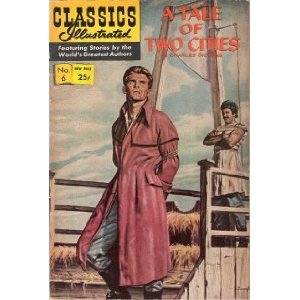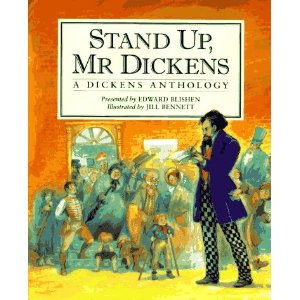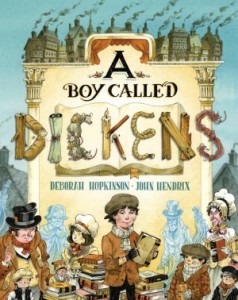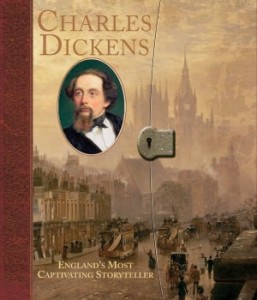 My first exposure to Charles Dickens was the original Classics Illustrated edition of A Tale of Two Cities. The last panel of Sidney Carton climbing the steps to the guillotine (“It is a far, far better thing I do now . . .”) is burned into my memory. So I’m perfectly fine with graphic-novel versions of classic stories as a gateway to the real thing. Classics Illustrated began an update of the series in the mid-eighties with a variety of artists and styles, including Great Expectations by Rick Geary and Oliver Twist by Loic Dauvillier. Both these artists use exaggerated comic styles that don’t work for me, but may appeal to a fifth-grader. They will get the job done if all you want is for your middle-grader to have some knowledge of the story; and since Dickens dialogue and narrative are used extensively throughout, these graphic versions can be seen as extreme abridgements.
My first exposure to Charles Dickens was the original Classics Illustrated edition of A Tale of Two Cities. The last panel of Sidney Carton climbing the steps to the guillotine (“It is a far, far better thing I do now . . .”) is burned into my memory. So I’m perfectly fine with graphic-novel versions of classic stories as a gateway to the real thing. Classics Illustrated began an update of the series in the mid-eighties with a variety of artists and styles, including Great Expectations by Rick Geary and Oliver Twist by Loic Dauvillier. Both these artists use exaggerated comic styles that don’t work for me, but may appeal to a fifth-grader. They will get the job done if all you want is for your middle-grader to have some knowledge of the story; and since Dickens dialogue and narrative are used extensively throughout, these graphic versions can be seen as extreme abridgements.
For graphic treatments of several stories in one volume, see Marcia Williams’ Charles Dickens and Friends. She writes for younger readers, so the stories are not as detailed as they would be in a one-volume comic, but the style isn’t for everybody. Some of her depictions of Fagin’s den or Pip’s moor may even be a little disturbing for younger kids.
everybody. Some of her depictions of Fagin’s den or Pip’s moor may even be a little disturbing for younger kids.
To bridge the gap between graphic novels and original works, I recommend Stand Up, Mr. Dickens: a Dickens Anthology, by Edward Blishen. Each chapter begins with an introduction that relates the chronology of the author’s life to his work, and gives some background to one of six novels. A long excerpt from the novel itself follows, which serves to give the young reader a taste of the Dickens style, and a sense of the plot. I can’t think of a better way to introduce a fifth or sixth-grader to Dickens.
These are all resources for getting to know the novels. For learning about the man himself, here are some recent books for the picture-book set and older:
A Boy Called Dickens, by Deborah Hopkinson, illustrated by John Hendrix. Schwartz & Wade, 2012, 40 pages. Age/interest level: 4-8.
The story focuses on the six months that Charles Dickens spent in the blacking factory off the Strand, which would seem like odd material for a picture book. But it’s well-told, as we follow the boy through his dreary work routine by day and street-wandering by night, as he observes the inhabitants: “All these characters and their stories swirl about the boy like the fog.” It’s well told and touching, and a convincing portrait of the experience that made its mark on the author’s work.
Charles Dickens: Scenes from an Extraordinary Life, written and illustrated by Mick Manning and Brita Granstrom. Frances Lindoln, 2011, 40 pages. Age/interest level: 8-12.
The author/illustrators use humor and telling detail to create this biography. The basic facts are well-enough known to indulge in a little elaboration, so here we have the recollection of Kate Dickens of how her father used to leap up from his writing desk to capture his own facial expressions for veracity. The major novels are included as strip cartoons—seems like we can’t get away from graphic treatments, but it’s fun.
Charles Dickens: England’s M ost Captivating Storyteller, by Catherine Wells-Cole. Candlewick, 2011, 32 pages. Age/interest level: 8-12.
ost Captivating Storyteller, by Catherine Wells-Cole. Candlewick, 2011, 32 pages. Age/interest level: 8-12.
The format of this biography is a little different, presented in the form of a notebook with a fold-over flap. The arrangement is different, too; instead of strict chronology, we get topics, such as “London,” “Christmas,” “the workhouse,” etc. The author makes use of original documents, diagrams, and illustrations, plus clever presentation. For instance, a lot of information is presented in the form of an Advent calendar with flaps. A letter written by young Charles to his first serious girlfriend Maria Beadnell is tucked inside an envelope for the reader to take out. The text is conversational and humorous, which should do as much to engage a reader as lifting flaps.
Charles Dickens and the Street Children of London, by Andrea Warren, Houghton Mifflin, 2011, 156 pages. Age/interest level: 12-up.
Andrea Warren, perhaps best known for her books about the Orphan Trains, here takes on not only the writer but also his social milieu. Her focus wavers from time to time, such as when she shifts to Thomas Coram and his establishment of the Foundling Hospital, or Dr. Barnardo who opened several homes for poor children. But Dickens was well known in his own time for raising consciousness about the state of the urban poor, of which of course he had firsthand experience. This book firmly establishes why consciousness needed to be raised and what charitable endeavors Dickens himself either began or inspired.
There are plenty of online resources, too, which I intended to cover in this post, but there’s too many. I’ll be back with them later this week–plus, video recommendations! It never ends!
Support our writers and help keep Redeemed Reader ad-free by joining the Redeemed Reader Fellowship.
Stay Up to Date!
Get the information you need to make wise choices about books for your children and teens.
Our weekly newsletter includes our latest reviews, related links from around the web, a featured book list, book trivia, and more. We never sell your information. You may unsubscribe at any time.
We'd love to hear from you!
Our comments are now limited to our members (both Silver and Golden Key). Members, you just need to log in with your normal log-in credentials!
Not a member yet? You can join the Silver Key ($2.99/month) for a free 2-week trial. Cancel at any time. Find out more about membership here.

